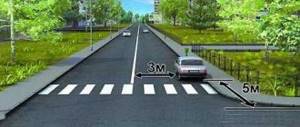How to choose a suitable parking spot
Many summer residents get to their country home by their own car, so upon arrival one serious question arises: “Where to park the car.” If you don’t want to leave your iron horse under the fence on the street side, you need to make a parking lot for it inside the site. It can be arranged in different ways. But first you need to decide where it is best to locate such an object.
Experts recommend parking the car as close to the front door of the house as possible. Then it will be easier to unload and bring into it food and things brought from the city, and then, when leaving, load canned goods and harvested crops into the trunk. If the gate is located far from the main entrance, it is better to arrange parking right next to it.
If there are no buildings near the entrance, the car will be flooded with rain and covered with snow during bad weather, and sand and leaves will settle on it in windy weather. Therefore, it is rational to make a platform for a car on the side of the house. Then at least one wall will protect the car on one side. When choosing a place and end, experts advise not to rush, but to observe where the wind most often blows. This will help you find the safest place for the car.
Parking at the side of the house Source shednation.com
Many, trying to protect their motorhomes from car thieves and burglars, rush to park the car right under the windows of the house. Experience shows that this is not the best place for parking. Firstly, all the greenery, tightly adjacent to the walls, is trampled down; flowers and trees cannot be grown on this heel; the panorama opening from the windows of the house suffers from this. Sometimes the car alarm goes off at the wrong time and wakes up everyone in the household. If there are elderly people and children in the family, such inconvenience often leads to a heart attack or hysterical crying.
The most common option for organizing a parking space is a place near the gate. In this situation, internal space is saved; a convenient path leads from the site to the house, which can be decorated very formally and, with the help of landscape gardening, make this part of the site very presentable. This is convenient if the gate is located next to the house. When both objects are located on opposite sides, you have to carry heavy loads by hand, loading and unloading the car.
Parking near the dacha gate Source avatanplus.com
The area under the car must correspond to the dimensions of the vehicle. If the owners drive a passenger car up to four meters long, the parking space should be 5x2.5 m in size. For jeeps and minivans, an area of 6.5x3.5 m is required. You can find a place for such an object in your dacha by opening the site plan and looking at how the main buildings are located. Modeling helps to facilitate the solution of the problem. You need to cut out a square on colored paper, on a scale corresponding to the dimensions of the vehicle and the scale of the site plan, and then apply it to different sides and see where the parking will “work” best.
Technical requirements for marking parking spaces
Basic technical requirements include not only the organization of the work area where the machines will be located, but also the selection of materials from which the entire incoming infrastructure is supposed to be made. Such objects include the fencing used, as well as the markings used. The important points are as follows:
- in the area of the local area, the boundaries of the parking lot must be clearly distinguishable, so side stones are used for zoning;
- vertical elements must be painted in courtyard parking lots with special reflective markings in order to be visible in the dark;
- To paint asphalt, you must use nitro paint or thermoplastic.
You should not use cheap water-based markings. It quickly wears off from moisture and precipitation, making it impossible to determine the boundaries of the parking lot. It is important to locate places for people with disabilities as close as possible to the entrances of buildings. Thanks to the expanded space on them, the driver will be able to open the stroller. There should be 10% of such places. Motorists can park their cars on such a site if they have the appropriate sign on the car and a certificate of disabled people of group 1 or 2, otherwise a fine of 5,000 rubles will be issued.
Arrangement options
Once the problem with choosing a location has been resolved, you can begin arranging the parking lot. You can organize it in different ways. The easiest way is to make an open parking lot.
The easiest way is to park the car directly on the lawn. But this option has its drawbacks. If you constantly park the car in the same place, a dense tread mark will form under it. Over time, the grass underneath will wrinkle and die, and bald spots will appear, which will be very difficult to restore. If you don’t have the desire or means to set up a permanent parking space, you can simply level the intended area and cover it with artificial turf. In this way, you can immediately solve two problems: maintain the presentable appearance of the green lawn and protect the ground from the pressure of wheels.
Parking a personal car on the lawn Source gongmedia.ru
An area covered with crushed stone or stone chips
This parking arrangement option is considered the most practical. In addition, such a parking lot looks quite aesthetically pleasing. To arrange the site, you need to remove the top fertile soil 10 cm thick, pour curbs along the edge, make a sand cushion at the bottom and lay a layer of gravel, crushed stone or stone chips 15 cm thick on top of it. All this will allow you to slightly raise the parking lot above the main soil level and prevent accumulation of water inside the rubble. Experts recommend pouring two concrete strips in the center of the parking lot to make it easier for cars to enter. There should be a distance between them equal to the distance between the wheels.
Parking lot for personal vehicles covered with rubble Source pinterest.com
See also: Catalog of companies that specialize in landscape work on sites and installation of metal structures.
Concrete parking lot
It is much more difficult to build, but it will last longer. It can be developed only in those regions where the soil is not prone to swelling. Such a parking lot is constructed as follows:
- Markings are made , a base is formed, and soil 20 cm thick is removed inside its perimeter. The space inside is cleared of debris, grass roots and other plants.
- After this, a layer of sand 10 cm thick is poured inside, it is poured abundantly with water, after which the pillow is thoroughly compacted.
- Formwork is being installed along the perimeter of the future parking lot . It can be made from edged boards.
- place a laying mesh on the surface of the compacted sand and fill it with the first layer of concrete. Its thickness should be at least 5 cm.
- Once the first layer of pouring has set slightly, you need to lay the reinforcement and fill it again with a five-centimeter layer of concrete on top.
The screed will take two or three days to dry in warm weather. If the sun is strong, experts recommend flooding the area with water several times a day. This will then further prevent cracking of the top surface of the screed. After three days, you can walk around the parking lot with your feet; the car needs to drive into it no earlier than three weeks after filling.
Concrete parking area Source pinterest.com
Parking lot made of paving slabs
If the soil swells in the spring, after a couple of seasons the durable concrete parking lot will become unusable; the screed will simply break open from the inside and crumble. In such cases, only the choice of tile material can save the situation. In order for the finishing coating to withstand the load of the machine, for the designated purposes it is worth choosing tiles with a thickness of at least 6 cm.
Anyone with basic construction skills can lay paving slabs for a dacha parking lot. The main thing is to build the foundation correctly. For an area with periodic entry of a passenger car, you must:
- mark the surface;
- cut off a layer of soil 20 cm thick, compact its bottom;
- make a cushion from crushed stone (it is important to choose a material for this with a fraction of up to 40 mm);
- lay geotextiles on top;
- build a sand cushion on top from a mixture of sand and cement in proportions 5x1;
- lay tiles ;
- fill the seams with a mixture of sand and cement.
If all layers are well compacted with a hand roller or vibrating plate, the parking lot will be level and the paving slabs will last a long time. If the base is poorly compacted, depressions will appear in the parking lot very soon.
Parking lot made of paving slabs Source 1nerudnyi.ru
See also: Catalog of garage projects presented at the Low-Rise Country exhibition.
Parking lot made of stone
In order for it to function normally, it is necessary to first construct high-quality drainage. To do this, the parking lot is first marked, then a hole half a meter deep is dug. Ditches emerge from it to a depth of 10 cm below the pit. In them, fine crushed stone is laid at the bottom, geotextiles are laid on it, and pipes are mounted on top (they need to be taken out into a special drainage well, which is located outside the site). The pipes on top are again covered with geotextiles and filled with crushed stone.
A geotextile film is laid at the bottom of the pit, and a cushion of two layers (crushed stone and sand) is constructed. Each one is carefully compacted. A rowan grouse mesh is spread on the sand, a layer of crushed stone 10 cm thick is poured onto it. A layer of screenings (a mixture of sand and cement) is placed on it. Each time after backfilling, you need to walk over the surface of the site with a roller and thoroughly compact the base. The final stage is laying the tile stone. The seam between two adjacent modules is filled with a mixture of cement and sand.
Open stone area for car parking Source sandstone.by
Natural stone is an environmentally friendly material; during operation of the parking lot, chemical components hazardous to human health will not evaporate from its surface. The parking lot will be very durable, wear-resistant, and outwardly it will look very respectable. And if you manage to connect it with the house using a path paved with the same stone, you can create a rather beautiful frame for landscape design.
Paving options and types of stones are selected taking into account personal preferences and financial capabilities.
Car in the country: garage, shed or parking space
Finally, the car needs a place so that it can be washed comfortably without poisoning the cucumbers with oil runoff, repaired or changed shoes. Garages, hangars, sheds and dedicated areas are suitable for these purposes. They all have their pros and cons. To avoid making mistakes, let’s study the experience of FORUMHOUSE users in constructing various car shelters.
If you decide to equip a place for a car on your property, start with a sober assessment of your needs and capabilities. Where a dacha is a second home, you cannot do without a garage. In addition, this building is multifunctional: in the garage you can place workbenches, shelving, and an inspection pit. Only in the garage can you equip a comfortable place for car repairs - heating, light, water. But it won't be cheap either. There is no point in going to serious expenses if you come several times during the summer - it’s better to think about how to make a parking lot at your dacha with your own hands. Spoiler: according to our forum members, the best option would be a crushed stone or concrete platform, preferably with a canopy. Yes, it will not save you from thieves, but the car will not leave picturesque ruts on the site, especially in the spring.
Whatever you choose, there are general rules for organizing car parking: it should be far from open fire (stove, brazier, barbecue, tandoor), located closer to the entrance and drainage ditch.
How to make a parking lot for a car at your dacha with your own hands
Let's start with the easy one - open parking. The simplest do-it-yourself dacha parking is a platform filled with crushed stone. This is what forum tester Mazanoff did (see photo).
This elegant solution has its advantages - it saves time and money. If the area is not "wet", the water will quickly drain through the loose material, so the machine does not have to stir up the dirt. However, crushed stone has a peculiarity - on damp, soft soil it actively sinks into the ground (up to 10 cm per year), so be prepared to buy additional bedding every year. If the site is not fenced with a border, the stone will scatter throughout the site.
Philo user FORUMHOUSE
I look at my neighbor, he pours three cubes of rubble every year - and it’s like a hole in the ground.
To prevent crushed stone from sinking into the soil, you need to make a base that will distribute pressure over the entire area of the designated area. To do this, the fertile layer is removed at the site - it can reach up to 60 cm, then geotextiles are laid - this material allows water to pass through, but does not allow the “pie” to sink. Crushed stone is poured on top of the geotextile - at least 10 cm. Experienced forum users advise choosing dolomite - over time it sets into a monolithic slab. The crushed stone is compacted, a layer of sand of 10 cm is laid on top and also compacted. It is necessary to pour the “pie” so that it “settles” well.
Sand is an unreliable coating. It needs to be closed, at least so as not to carry it on your feet into the house. The final coating can be different - a layer of crushed stone, concrete, asphalt, cobblestones or paving slabs, as on the site of forum member 1984Vlad.
1984Vlad member of FORUMHOUSE
This is how the parking lot turned out, 33 sq.m. From the edge where the road is, they laid a curb flat - to organize the entrance to the parking lot, there was a small bump there.
In the photo: parking in a damp place with your own hands.
Some users insist that it is better to first put sand on the geotextile with layer-by-layer compaction, then crushed stone of fraction 20-40, and screenings on top. Forum member VasiliyB completely abandoned sand.
VasiliyB member of FORUMHOUSE
Granite crushed stone of fraction 20-40 was spread on geotextiles in a layer of 10-12 cm, and passed through with a vibrating rammer and pouring. Next, we spread crushed stone of fraction 5-20 in a layer of 5 cm, and went through it with a vibrating rammer and pouring. The next layer is screening out fractions 0-10, a 5 cm layer, pouring, tamping.
It turned out like this:
If the soil is rich in clay and groundwater flows nearby, it is better not to skimp on geotextiles - without it, the crushed stone will sink into the damp ground in a couple of years.
When choosing geotextiles, make sure that it is intended for road work. A material similar in appearance is used for vapor barrier of roofs and other construction work. It doesn't allow water to pass through and if you mess it up, you'll end up with a "bathtub" instead of a parking space.
What to make a foundation for a truck at the dacha
If trucks will enter the car area, it is better to choose tiles 6 cm thick. Three-centimeter ones may not withstand the pressure and will crack. But it would be safer to install formwork and fill the surface with concrete, having previously reinforced it with a steel lattice (some resourceful forum users used the backs and nets of old beds for this). Since the parking lot will be higher than the ground, it makes sense to additionally reinforce the corners and edges. Large areas will also require cutting thermal joints - otherwise the concrete will crack due to temperature changes.
Maintain a slope so that dirt from the wheels and water after washing the truck do not flow onto the site, but into the drain and drainage ditch. If the site is “wet” and the groundwater is high, you will need to install a full-fledged drainage system. You can easily find how to do this in the corresponding FORUMHOUSE section.
Wintt member FORUMHOUSE
I decided for myself that the water should flow towards the gate and to the right (when viewed from the gate) - subsequently I will organize a discharge tray there.
As a finishing coating for a parking lot, you can also use special “honeycombs” - lawn or geogrid. The first is filled with soil in which the lawn grows, and the second with crushed stone.
Both structures are made to strengthen the surface, but only a geogrid covered with gravel will withstand heavy machines, which we can see in the user Fedotov.
Fedotov
It does not spread, does not go into the ground, does not become overgrown with grass (2 years have passed).
Entry for a car at the dacha. photo.
An important question is which crushed stone to choose for the top layer of the parking lot. The 40/70 fraction will help get rid of the effect of “crushed stone leakage” under the wheels (when front-wheel drive cars get stuck), but to work with a large fraction you will need special equipment. The best option is to choose a more convenient crushed stone of fraction 20/40, but fill it with screenings on top.
DamaZk member of FORUMHOUSE
If the sand lies under the crushed stone (crushed stone is visible, not sand), then the simplest thing is to screen out the crushed stone. They filled it up, leveled it, spilled some water and that was it. The screenings set over time and hold the surface. That's how it is.
If you don’t want to pull out weeds from screenings and crushed stone, take a closer look at asphalt chips. To increase strength, some users recommend lightly pouring used oil over the crumbs (look for them in small car repair shops) - then it will become a “stone”. But do not overdo it, otherwise the surface will be soft.
To set up an open parking lot, you can use different “non-living materials” - broken bricks instead of crushed stone, broken concrete, but the result will be unpredictable - in some places the parking lot will last ten years, and in others – a year.
If the site has a significant slope, you cannot do without pouring a concrete slab. You can save on concrete if you pour a tape around the perimeter of the parking area, fill the resulting “box” with soil, and then add sand and everything else on top of it. This is what forum member Donsss did:
An awning or canopy made of polycarbonate sheet will help to protect your car from rain and sun. Read about the nuances of building mobile sheds in this topic.
Garages
A garage is a more solid structure than a car storage area, so it requires a thorough approach - even when choosing a location. To save space and money, the garage is combined using a common wall with the house or bathhouse. Both solutions are a priori not the best: the proximity to the bathhouse is risky from the point of view of fire safety, and the entrance from the house to the garage threatens with unpleasant odors in the house (oils, gasoline fumes). If the garage is not insulated, its gate is not even a bridge, but a cold bridge through which heat will escape in winter. Ideally, the garage should be a separate building, but if you are designing it in conjunction with a house, immediately plan for insulation. Including the gate.
One way or another, the project must necessarily provide for engineering systems: water supply (for a mini-wash), drainage, ventilation, power supply, lighting, and, if necessary, an alarm system. For each of them you will find recommendations on FORUMHOUSE.
If you are designing a garage on the border of a plot, do not forget about the “red line” - in some regions, for the construction of capital objects on a foundation, you need to step back from the fence 2-5 meters so as not to affect utility lines. All details are in your territorial administration.
Unogroup member of FORUMHOUSE
I have industrial water running between the plots, and it seems that according to all the laws I can build 1 meter from the border of the plot, but in fact the architect gave me a limit of 3 meters.
When calculating the dimensions of your garage, look to the future. While it is not difficult to expand an open area, such a number will not work with a garage. Passenger cars, on average, are becoming longer, so it is better to immediately lay at least 5.5 m for one car. Plus 50 cm from each edge to drive in without wiping the walls. Take into account the features of the body - to open the rear door of a station wagon, you will need about 70 cm. Finally, immediately decide on which side there will be racks for tools and places for household equipment - reflect this in the project. The optimal length of a garage not combined with a workshop is 7 m.
The width of the garage is calculated according to the formula: 3 m for each car plus a meter for “comfort” - so that you can vacuum a car with the doors open and squeeze through with bags.
When calculating the opening for the gate, keep in mind that there must be at least 50 cm of wall from the gate posts to the corner, then the structure will be more reliable. Above the gate, it makes sense to lay a beam with a cross-section designed to support the weight of the gate. The height of the opening depends on the height of the machine. For a regular sedan, 2.2-2.4 m is enough, and for an SUV (middle wheels plus trunk) - at least 2.7 m.
madman_zhuk FORUMHOUSE member
Still, it’s better to make two gates: one large and one smaller, otherwise you’ll suddenly want to buy a minibus. Plus, if one breaks down, the other will be released and let in.
The width of the entrance gate should be selected based on the characteristics of the entrance. So, when entering perpendicular to the gate plane, the opening should be 0.7 m wider than the car and 1 m wider if you have to enter at an angle.
Having chosen a place for a garage and decided on its dimensions, think about the material for the walls - many design features of the building depend on this. The range here is wide, the walls can be made from the following materials: brick, slag, foam, gas, sand and expanded clay concrete blocks, as well as various variations on a metal or wooden frame - metal profiles, SIP panels, plywood, OSB boards.
Thus, forum member MBogdanov chose brick for the facade layer of the garage, since it had to match the exterior of the house. For the second, inner layer, the owner thought to choose expanded clay concrete, which is cheaper and easier to lay. But facing brick is a material that does not require finishing. Having estimated the costs of plastering and painting work with blocks, the forum member came to the conclusion that both options were comparable in cost and decided to build the walls with two facing bricks. An excellent solution for a warm, permanent garage!
Sand concrete and expanded clay concrete blocks are cheaper than others, but they require external and internal finishing, as they have problems with geometry. Silicate, foam and gas blocks are smoother, but more expensive. The benefits should be considered after finishing.
It makes sense to have a heated garage if you constantly live outside the city. Otherwise, it is better to choose a cold (for the summer) or insulated (with the ability to quickly warm up with a heat gun) option.
DENdi
If you rarely heat, then you can use a potbelly stove - my father and I can heat up to +20 in an uninsulated garage. If it's constant, you need a heating system. At GSK, the guys doing the repairs made water heating from the same potbelly stove and filled it with antifreeze. In the morning it never gets below +10 in an uninsulated garage.
You can make a “warm” garage from any material, the only question is the insulation technology. However, aerated concrete is a priori warmer than sand block, and foam block warms up faster than cinder block. When insulating a garage, remember that most of the heat escapes through the gates and ventilation. You cannot refuse them, but you can insulate them.
Typically, experienced builders advise choosing a material for a garage that will be cheaper in your area (production and delivery features). The main thing is not to forget about the general rules of construction: the foundation must withstand the load from the walls and roof, the roof must not retain snow, the rigidity of the walls must be sufficient for wind and other loads. Everything requires an engineering calculation.
Frame technology is less reliable in terms of fire safety and protection against theft. But frames have a lot of other advantages: it’s faster to build, cheaper, and you can do it alone.
Mitrich1978
I'll share my craft. The frame is made of 50x150 boards, inside there is OSB, outside there is siding without insulation, the foundation is shallow, inside there is a 10 cm concrete slab.
You can protect a building from fire using non-combustible materials: a metal frame and profile, sheathing made of cement-bonded particle board, plasterboard or flat slate. Walls are usually insulated with polystyrene foam, mineral wool or ecowool.
If you are not going to insulate the garage, you can save money on the internal lining, although this will violate fire safety standards, and the extra ligament will not harm the frame.
Keyman member FORUMHOUSE
Insulation will prevent you from creating a steam room in the garage in the summer. I can tolerate heat worse than cold.
Alas, the burglary resistance of frame buildings is ridiculous, so leaving your car in such a garage for a long time is not worth it. But blocks will not always help in this case - the same foam concrete is sawed with an ordinary hacksaw for metal. But solid expanded clay concrete blocks are a stronger material. Especially if you line them with brick.
A frame garage made from SIP panels can be heated much faster than one made from brick or block. The panels do not need to be plastered; it is enough to cover them with clapboard. Finally, this technology implies a lightweight foundation - and this is a significant saving.
stepanstroy member of FORUMHOUSE
My neighbor on the property made a garage out of foam blocks - cracks appeared, i.e. they need a more solid foundation. And here - they poured about 15 cm of screed onto the mesh, tied it around the perimeter, installed panels, and let it float along with the walls.
The foundation for a garage is of great importance. It will bear the weight of not only the walls, rafters and roof, but also the car. Theoretically, all types of foundations are suitable for these purposes - pile, strip and slab, but a garage on stilts is almost exotic if the site is more or less flat and dry. A monolithic slab is the most reliable option, especially since you immediately get a floor. In a small garage space, the costs will not be much higher than for a strip foundation. But even here an accurate calculation is needed. Read about the pros and cons of various foundations in this section.
fogel member FORUMHOUSE
I have a garage like this, it’s still in the process of being completed. The foundation is a ribbon. I would do it now, pour the slab right away and assemble it from SIP panels, less difficulties, more results.
The basis for the garage resembles the basis for an open parking lot: a crushed stone-sand cushion and a 10-20 cm concrete screed reinforced with mesh. However, there are some nuances. So, the foundation of the garage must be insulated. Foam blind areas will protect it from freezing of the soil. It is better to make the basement of the garage from baked brick.
If the area floods in the spring or the groundwater is very close to the surface, you will need a drainage pipe system and a drainage well. Don't forget about the drain if you wash your car in the garage.
Ventilation in the garage is required. The diameter of the exhaust pipe depends on the area of the room; they are installed on the roof or at the top of the wall. The inlet openings are located below - in the gate or next to it. In winter, the air flow is reduced so as not to chill the room.
For garage lighting, it is recommended to choose fluorescent lamps. Halogen or LED are suitable for lighting the entrance to the garage.
Keyman member FORUMHOUSE
Two tips. Do not place lamps on the axis of the entrance; they should illuminate the area and not shine into your eyes. Use more than one lamp, placing them opposite each other, this will avoid shadows.
Unsupported spans of a garage, especially a frame one, usually leave no choice when arranging a rafter system - only trusses. A narrow garage can be covered with wooden beams. If the length of the garage is more than 6 m, you will also need a channel. The reinforced concrete floor slab impresses with its tactical and technical characteristics, but it is not suitable for all garages, as it is too heavy. The cheapest roof is a single-pitch roof with a slight slope, but a gable roof allows you to better “spread” the snow load and equip the attic. Do not forget about the reinforcing belt, it is needed even if a Mauerlat is supposed to be used.
If the garage is unheated, a simple “pie” will be enough - sheathing, OSB board, flexible tiles (slate, profile). If it is heated, and even with a usable attic, then it’s a complete “stuffing” with insulation, vapor barrier, ventilation ducts, etc.
One of the main mistakes when building a garage is thin walls and a lack of reinforcing elements.
Oleg 61 FORUMHOUSE participant
Before winter, a neighbor built a garage for two cars from foam blocks 150 mm wide; in the summer he wanted to cover it with half a brick. On March 16 in Rostov-on-Don there was a strong wind and the garage collapsed.
In this case, for an 8-meter wall with a height of more than two meters, the block width was clearly insufficient. There is no reinforced belt under the roof, and there is no reinforcement or masonry mesh in the rows.
User Alexey Tay's rafters in his garage burst due to snow load.
Alexey Taya
Instead of a roof, a bowl formed in which 50 m2 of snow floated, that’s 5-10 tons. By some miracle the walls did not fold inward. The reason is poor-quality rafters, many large knots. The size should have held the load, but the knots...
And others
An alternative to a garage is a stationary shed. This is no longer just a parking lot, but a real multi-purpose building. Forum member Recusal chose the following design:
Withdrawal member FORUMHOUSE
Two cars pull in. You can drive an onboard gazelle. You can dry the board. Warehouse for large items. With a slight movement of the hand it turns into a summer kitchen. In the fall, the canopy was covered with corrugated sheeting to protect against the south wind. In winter, the visor hung from slanting rain and snow.
Forum member Roracotta installed a canopy on 8 pillars with a diameter of 30 cm. The pillars are immersed 120cm deep. Boats, equipment, tractors are stored here:
User chichic chose to make a full-fledged hangar.
Chichic member of FORUMHOUSE
For my purposes, a garage was not needed. I had no intention of setting up a permanent workshop there. The task was to shelter equipment from rain and snow, park a passenger car, store various materials and things.
The hangar is made of converted greenhouse arches and galvanized corrugated sheets. These arches were designed to hold glass, so they are especially durable. Arches made under polycarbonate are not suitable for a hangar. The frame is made of reinforcement, filled with concrete.
The simplest option for arranging a parking lot for a car is to put the car under an awning. Manufacturers even call such tents “tent garages.”
Andrey Dacha FORUMHOUSE member
Garage in a box, took three hours to assemble, size 4x6, height 3.7... Includes 4 pcs 75 cm anchors. and bought 4 more, for a total of 8 anchors it sits quite tightly.
Another mobile option is the well-known shell garage and pencil case garage, which do not have a bottom. There is even a garage based on a caravan - formally that is what it is, that is, it is registered as a vehicle.
In this FORUMHOUSE section, read how to build a garage in any conditions. Familiarize yourself with the nuances of frame construction. Read about pitched roof carports and freestanding carports. In this thread, forum members are discussing the organization of parking for a car. Watch a video about garage doors.
Parking with canopy
When the owners come to the dacha for a long time, it makes sense to build a canopy over the open area. You should not install it high, in such a situation the canopy will turn into a sail. It will be shaken by the wind, and the car itself will remain accessible to side precipitation. To determine the correct height, experts recommend using the formula (the height of the car plus the height of the possible load on its top). On average, it turns out to be 2-2.5 m. Canopies are usually installed as follows.
A concrete base is also installed, support pillars are installed immediately, if tile material is used to arrange the parking lot, the supports are pre-concreted, and only then the base is poured.
Parking at the dacha with a canopy made using wooden beams Source yastroyu.ru
Improvement of parking space
Your car always needs to be looked after. It will be easier to do this if you make the parking lot both comfortable and beautiful at the same time. For this, experts recommend:
- Provide electricity to the parking lot (this is not a whim, not a waste of time, light under a canopy or in a garage will allow you to park safely at night, repair your car, and load and unload the trunk without any problems).
- Bring water to the parking lot (you can simply run and throw a watering hose, install a pump, then you can simply wash your car and save on trips to car washes).
- Take care of the drainage system (it is installed on the water discharge side).
- Carry out landscaping of the surrounding area.
The last point is not mandatory, but if the parking lot is properly designed using landscape design, it will turn from a purely technical object into one of the design elements of the local area and will become part of the summer cottage. If the parking lot has a canopy, it can be decorated with climbing plants. Anyone who chooses them correctly will be able to create a cozy green office for their transport space.
Landscaping of a parking lot at the dacha Source autotrader.ca
The open area needs to be landscaped along the entire perimeter, branched trees and shrubs should be planted along it. Conifers planted in a row (arborvitae, dwarf fir, juniper) look very decorative. When there is a desire to create a joyful mood, the entire area around the entrance should be turned into a flower garden. Flowerbeds in which redbeckias, petunias, and zinnias were planted always look great.
Defining a parking lot
The parking area is a fenced part of the road space, which is indicated by markings and a special sign. According to the Traffic Rules, parking zones are designated by the letter “P”. This image is for informational purposes only and is most often used in conjunction with other instructions (for example, about how to park a vehicle).
Places for temporary parking of a car can be provided:
- paid;
- free of charge.
To park for free, vehicles can be left in public areas (in open areas, areas, near shopping centers specially equipped for such areas). Paid car parking can be installed at the entrances to strategically important objects (airports, railway stations), or to private protected areas.
Reference. Long-term parking services are provided for a fee near shopping centers and are accompanied by security or video surveillance.
Staying in the parking zone can last for a few minutes or for months, if the rules for leaving a car in a specific zone allow the car to be placed under guard. In the latter case, the parking lot will have the status of a parking lot and will be regulated by special rules for the provision of long-term car storage services.









